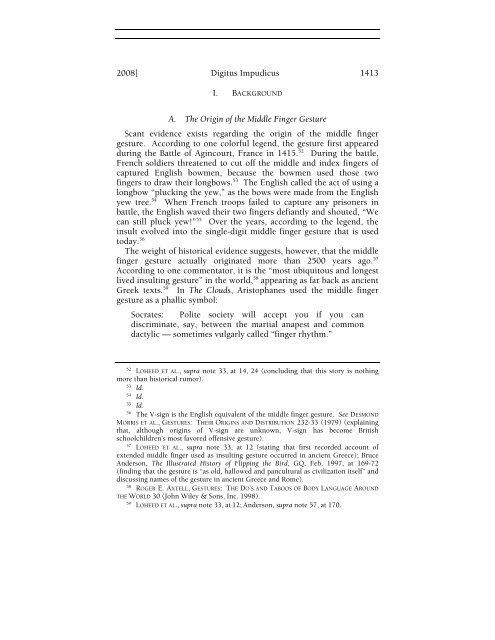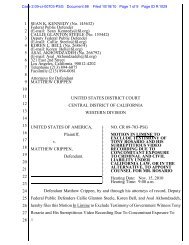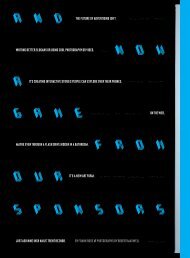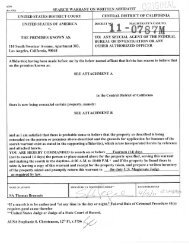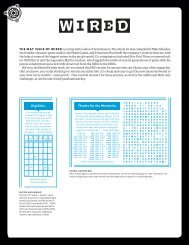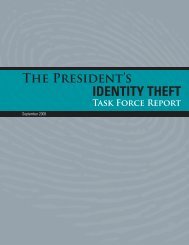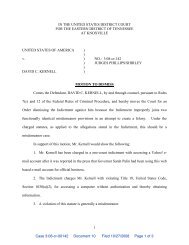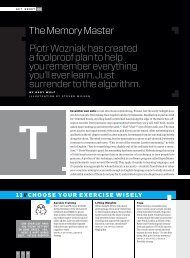Digitus Impudicus: The Middle Finger and the Law - Wired
Digitus Impudicus: The Middle Finger and the Law - Wired
Digitus Impudicus: The Middle Finger and the Law - Wired
Create successful ePaper yourself
Turn your PDF publications into a flip-book with our unique Google optimized e-Paper software.
2008] <strong>Digitus</strong> <strong>Impudicus</strong> 1413<br />
I. BACKGROUND<br />
A. <strong>The</strong> Origin of <strong>the</strong> <strong>Middle</strong> <strong>Finger</strong> Gesture<br />
Scant evidence exists regarding <strong>the</strong> origin of <strong>the</strong> middle finger<br />
gesture. According to one colorful legend, <strong>the</strong> gesture first appeared<br />
during <strong>the</strong> Battle of Agincourt, France in 1415. 52 During <strong>the</strong> battle,<br />
French soldiers threatened to cut off <strong>the</strong> middle <strong>and</strong> index fingers of<br />
captured English bowmen, because <strong>the</strong> bowmen used those two<br />
fingers to draw <strong>the</strong>ir longbows. 53 <strong>The</strong> English called <strong>the</strong> act of using a<br />
longbow “plucking <strong>the</strong> yew,” as <strong>the</strong> bows were made from <strong>the</strong> English<br />
yew tree. 54 When French troops failed to capture any prisoners in<br />
battle, <strong>the</strong> English waved <strong>the</strong>ir two fingers defiantly <strong>and</strong> shouted, “We<br />
can still pluck yew!” 55 Over <strong>the</strong> years, according to <strong>the</strong> legend, <strong>the</strong><br />
insult evolved into <strong>the</strong> single-digit middle finger gesture that is used<br />
today. 56<br />
<strong>The</strong> weight of historical evidence suggests, however, that <strong>the</strong> middle<br />
finger gesture actually originated more than 2500 years ago. 57<br />
According to one commentator, it is <strong>the</strong> “most ubiquitous <strong>and</strong> longest<br />
lived insulting gesture” in <strong>the</strong> world, 58 appearing as far back as ancient<br />
Greek texts. 59 In <strong>The</strong> Clouds, Aristophanes used <strong>the</strong> middle finger<br />
gesture as a phallic symbol:<br />
Socrates: Polite society will accept you if you can<br />
discriminate, say, between <strong>the</strong> martial anapest <strong>and</strong> common<br />
dactylic — sometimes vulgarly called “finger rhythm.”<br />
52<br />
LOHEED ET AL., supra note 33, at 14, 24 (concluding that this story is nothing<br />
more than historical rumor).<br />
53 Id.<br />
54 Id.<br />
55 Id.<br />
56 <strong>The</strong> V-sign is <strong>the</strong> English equivalent of <strong>the</strong> middle finger gesture. See DESMOND<br />
MORRIS ET AL., GESTURES: THEIR ORIGINS AND DISTRIBUTION 232-33 (1979) (explaining<br />
that, although origins of V-sign are unknown, V-sign has become British<br />
schoolchildren’s most favored offensive gesture).<br />
57<br />
LOHEED ET AL., supra note 33, at 12 (stating that first recorded account of<br />
extended middle finger used as insulting gesture occurred in ancient Greece); Bruce<br />
Anderson, <strong>The</strong> Illustrated History of Flipping <strong>the</strong> Bird, GQ, Feb. 1997, at 169-72<br />
(finding that <strong>the</strong> gesture is “as old, hallowed <strong>and</strong> pancultural as civilization itself” <strong>and</strong><br />
discussing names of <strong>the</strong> gesture in ancient Greece <strong>and</strong> Rome).<br />
58<br />
ROGER E. AXTELL, GESTURES: THE DO’S AND TABOOS OF BODY LANGUAGE AROUND<br />
THE WORLD 30 (John Wiley & Sons, Inc. 1998).<br />
59<br />
LOHEED ET AL., supra note 33, at 12; Anderson, supra note 57, at 170.


